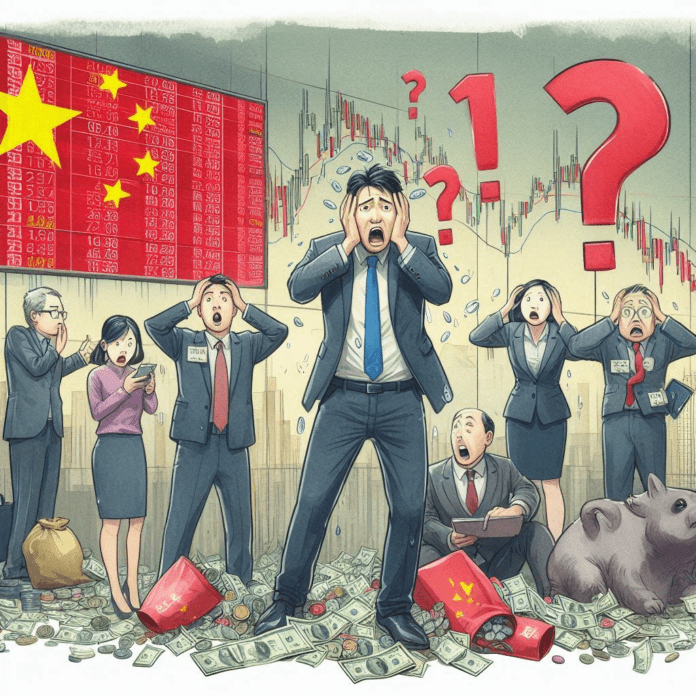China, once a thriving hub for global investment, is now witnessing an alarming economic slowdown. This downturn is leading to a mass exodus of funds from the country by panic investors. In the last quarter alone, panic investors pulled out a staggering $15 billion. This withdrawal is seen as a direct response to the deteriorating economic conditions in China, which have been steadily worsening over recent years.
China’s Economic Slowdown and Panic Investors
The latest data, released by the State Administration of Foreign Exchange, reveals that China’s balance of payments has taken a severe hit. The direct investment liabilities in the country fell by nearly $15 billion between April and June 2024. This significant drop marks only the second time such a negative figure has been recorded. Over the first six months of the year, the investment situation remained bleak, with a mere $5 million decline.
According to reports, if this trend continues throughout the year, it could result in the first annual net outflow of investment since 1990. This potential outcome highlights the gravity of the situation, as China has historically been a magnet for foreign investment. However, recent trends show a drastic shift, with foreign investment numbers plummeting after reaching a peak of $344 billion in 2021.
China’s Historic Dump of $53 Billion US Treasuries is Unprecedented Blow to US Economy
Geopolitical Tensions and Economic Shifts
Several factors are contributing to the growing number of panic investors in China. The economic slowdown is undoubtedly a significant concern, but rising geopolitical tensions are also playing a crucial role. These tensions have created a sense of uncertainty, making investors hesitant to commit their money to the Chinese market.
Another key factor is the rapid transition to electric vehicles (EVs) within China. This shift has had a profound impact on foreign car manufacturers, many of whom are scaling back their investments or pulling out of the market entirely. The sudden change in direction has left these companies scrambling to adjust, further dampening their interest in maintaining a presence in China.
Sanctions Clash: US Lawmakers Push to Ban Chinese Battery Giants Linked to Uyghur Forced Labor
Moreover, advanced economies are currently offering higher interest rates, making them more attractive to investors. Unlike China, which has been lowering its interest rates in an attempt to stimulate its economy, other nations are providing better returns on investments. This discrepancy has given multinational companies ample reason to redirect their funds to countries where they can expect higher profits.
China’s Struggles to Attract Foreign Investment
Despite its status as the world’s second-largest economy, China has been struggling to retain panic investors. The government has made numerous efforts to portray the country as open and welcoming to foreign businesses. They have been actively seeking to attract companies from overseas, hoping to bring in advanced technologies and resist pressure from other nations to decouple from China.
However, these attempts have largely been unsuccessful, as evidenced by the sharp decline in foreign direct investment (FDI). The latest figures show that new FDI into China in the first half of 2024 was the lowest since the start of the COVID-19 pandemic in 2020. This drop underscores the challenges China faces in maintaining its appeal to panic investors.
In contrast, Chinese companies are increasingly looking abroad for investment opportunities. In the second quarter of 2024, outbound investment reached a new high, with Chinese firms investing $71 billion overseas.
China’s Lingshui 36-1 Discovery in South China Sea Triggers Major Regional Tensions
This figure represents an increase of over 80% compared to the same period last year. Much of this investment is directed towards projects like electric vehicles and battery factories, as Chinese companies seek to expand their influence in these growing industries.
Discrepancies in Trade Figures
The economic troubles in China are further complicated by discrepancies in trade figures. The data released by the State Administration of Foreign Exchange revealed a growing gap in the measurement of China’s trade surplus. In the second quarter of 2024, the trade surplus reached a record $87 billion, bringing the total for the first half of the year to nearly $150 billion.
China Warns of Severe Retaliation if EU Pursues Trade Deal Investigations
This significant difference in trade figures has raised eyebrows, particularly in the United States. Earlier this year, the US Treasury called on China to explain the substantial discrepancies in trade data. According to a recent report by the International Monetary Fund (IMF), these differences are primarily due to “different methodologies used to record exports and imports of goods.”
The widening gap in trade figures adds another layer of complexity to China’s economic challenges. As the country grapples with an economic slowdown, geopolitical tensions, and a decline in foreign investment, these discrepancies only serve to heighten concerns about the stability and transparency of China’s financial reporting.


